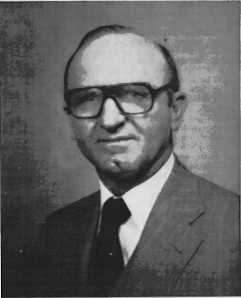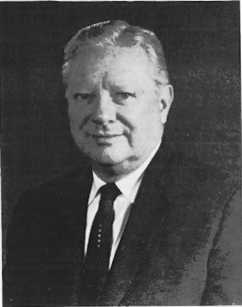|
|
presence there would be of some help. I recognized that
there would always be one crisis or another which might
delay my education, so I applied for a Carl Raymond Gray
(Union Pacific) Scholarship. The scholarship only amounted
to one hundred dollars and it was awarded to me in the
spring of 1946. At that time, I was also active in the
Future Farmers of America Association at the Columbus High
School, and I was named the First Star Farmer of Nebraska in
April 1946. After we had finished picking corn in 1946, my
parents agreed that if I were going to enroll at the
University that I should do so in January of 1947. I
followed their advice and was graduated from the University
of Nebraska in June of 1950. 1 returned to Butler County
where I taught a class of agricultural veterans in the
county intermittently for seven years. I also began farming
there in the spring of 1950.
In August 1950, I was married to Irene
Squire to [sic] Ashland. We are the parents of ten
children, Marcia, Mary, Steven, Julie, John, Micelle, Sue,
Jean, Lori, and Michael; daughter-in-law Diane, two
grandchildren, Paul and Ryan Schmit, and a son-in-law John
Albin.
During the entire time that I was in the
University and after I began farming I continued my interest
in politics and the Republican Party. I worked in a number
of congressional campaigns, including the late R. D. (Bob)
Harrison, of Norfolk, Nebraska, who became my very close
friend. I also worked in the Eisenhower and Nixon campaigns
in 1952 and 1956.
1 was elected to the Board of Directors
for the Columbus Production Credit Association, a position
which I held for twelve years. At the time of my election to
that Board, I was the youngest director in this region. I
served as Director of the Bellwood Watershed for twelve
years. In 1959, I was elected State Chairman of the Nebaska
[sic] Young Republicans.
In 1960, I made my first attempt to be
elected to a major political office when I filed for the
Republican nomination to Congress from the 3rd congressional
district. I ran second in the field of four candidates.
Ralph Beerman was nominated and later was elected to the
Congress. In 1966, I again filed for the Republican
nomination to the Congress from the new 1st congressional
district. I was defeated that time by Robert Denny, who was
elected to the Congress.
In 1968, I filed for the Nebraska
Unicameral Legislature and was elected to my first four year
term. I was subsequently re- elected in 1972 and 1976, and I
am again a candidate for that same office in 1980.
In 1978, I made another attempt to be
nominated to the Congress and was defeated again by Douglas
Bereuter, who is serving as a Congressman in the 1st
congressional district.
During my legislative career, I introduced
the following bills that were passed into law.
In 1969, I introduced LB 521 which created
the Office of the Ombudsman, the first Consumer Protection
Agency which provides consumer protection from an over
aggressive state government; in 1971, I introduced LB 939
which created the Department of Environmental Control and
established the Department of Environmental Control Council
with broad representation from agriculture, industry,
business and conservation groups. This department has been
one of the most successful environmental state agencies in
the nation.
In 1971, we passed LB 776, which
established the Nebraska Agricultural Products Industrial
Utilization Committee, popularly known as the Gasohol
Committee. Though ridiculed for my efforts at that time,
Gasohol has today become an international word and has been
recognized by President Carter and members of the Congress
as one of the major alternate sources of energy available to
citizens of the United States. I have been recognized, both
here and abroad, as the "Father of the Gasohol Movement," an
honor which I must share with many others. The development
of this source of energy could well be the most positive
factor affecting agriculture in many years.
In 1973, LB 312 was introduced and passed
into law, which allowed banks to have two auxiliary teller
offices.
In 1973, LB 477, the Catastrophic Illness
Bill, was introduced to provide relief to citizens from the
devastating
|
|
effects of illness not covered by medical insurance. This
bill is of particular importance to farmers because farm
families frequently possess non-liquid assets which are
unavailable for the purpose of paying such bills but are
considered as available resources which prevent farm
families from participating in the other assistance programs
which are available to non-farm families. This bill is
designed to keep families from becoming impoverished by
medical expenses before receiving some assistance.
In 1973, LB 101, the Physicians Assistant
Bill, was passed which provided badly needed medical
assistants for doctors in rural areas to better serve rural
constituents.
In 1976, LB 703, the Medical Malpractice
Bill, passed by a large margin, provided for the retention
of adequate medical personnel in this state by providing
limitations to the amount of malpractice claims.
In 1977 introduced and passed in 1978, LB
258 made available to the Nebraska banks for lending
purposes to citizens for their use more than one hundred
million surplus state dollars while earning competitive
rates.
In 1977, LB 518, and in 1980, LB 882,
repealed the personal property tax on livestock, farm
equipment, and business inventory resulting in a more
positive economic climate for Nebraska's agriculture and
business.
I introduced the bills which established
the drug abuse control program within the Nebraska State
Patrol.
I introduced and passed into law a series
of child support payment bills later copied by many
states.
I refused to accept federal domination of
agricultural chemicals by adopting Nebraska's own plan for
education and training of farmers, ranchers, and commercial
applicators of chemicals --- one of the two states in the
nation which refused to accept federal dictates. The
Nebraska plan operates for a fraction of the cost estimated
by the federal government.
As Chairman of the Agriculture and
Environment Committee, I introduced the bill which provides
for the joint construction of a School of Veterinary
Medicine by the Old West Regional Commission member states.
Also, as Chairman of the Agriculture and Environment
Committee, I was instrumental in securing the Vice
Chancellorship for the University of Nebraska Institute of
Agriculture and Natural Resources by legislative action.
In 1971, I was nominated to the Eagleton
Institute as one of the fifty outstanding state legislators
in the United States.
I serve as Chairman of a National
Committee of State Legislators Committee on Renewable
Energy, and was the first Nebraska State Senator to be named
Chairman of a National Conference of State Legislatures Task
Force (a 100 member Committee on Agriculture and Food)
representing more than 7,000 state legislators.
I serve as Chairman of the Beef Anti-trust
Committee, which successfully negotiated an agreement
between livestock producers and chain stores resulting in a
cash settlement for the producers, and an agreement not to
engage in certain practices detrimental to livestock
producers and feeders.
During the time that I was involved with
my political career, I continued to expand my farming
operation into Butler, Saunders, and Holt counties. I also
established, in 1967, the Mid-America Helicopter Services,
Inc., which I operated until March of 1977.
All of my professional and commercial
activity has been connected with agriculture. When our
ancestors founded this nation, it is my belief that they
intended that it should be governed principally by citizen
legislators who would leave their businesses, farms and
professions for a period of time to assist our neighbors in
the governing of the country. I do not believe it was ever
intended that politics should be a lifetime career. I am now
almost 51 years of age and I hope that during my lifetime I
have been able to make a small contribution for the
betterment of the state and nation as a farmer, livestock
man, pilot, and politician.
Schmit was also inducted into the Nebraska
Hall of Agriculltural [sic] Achievement in 1980.
Since 1917, the organization has honored
one or more
|
|

